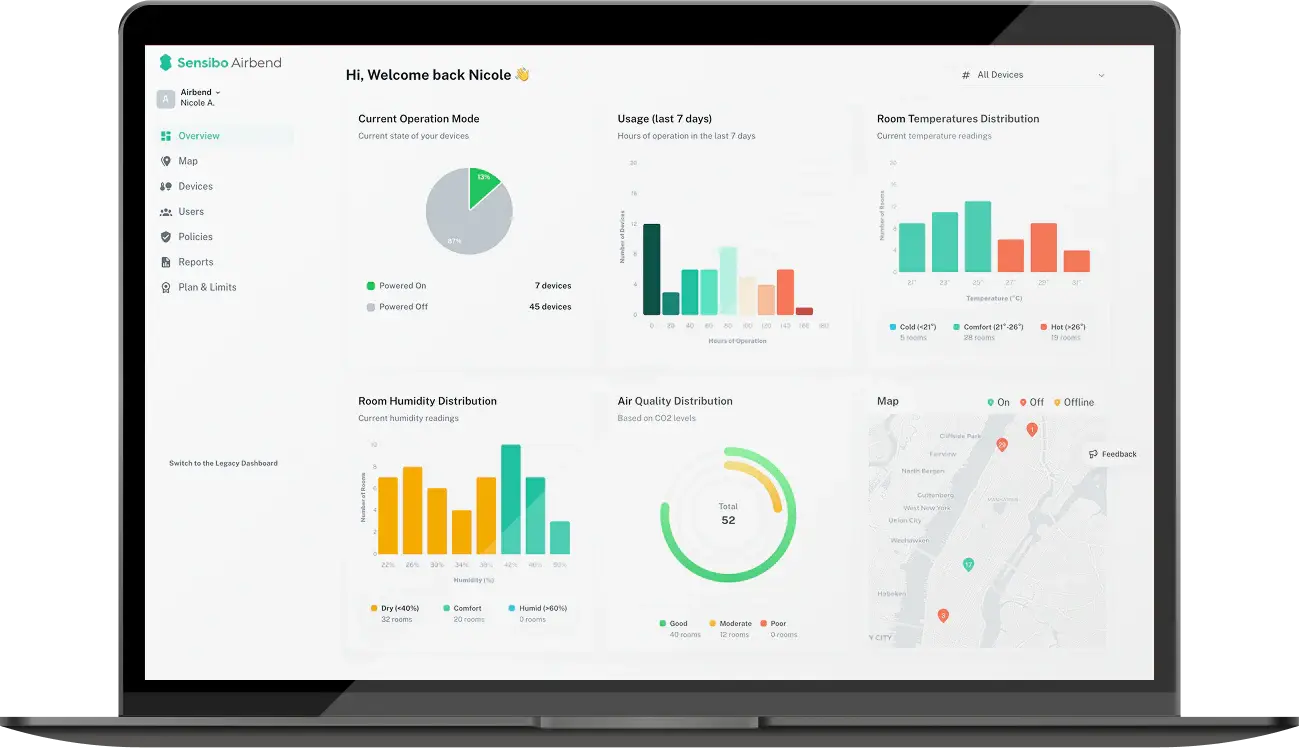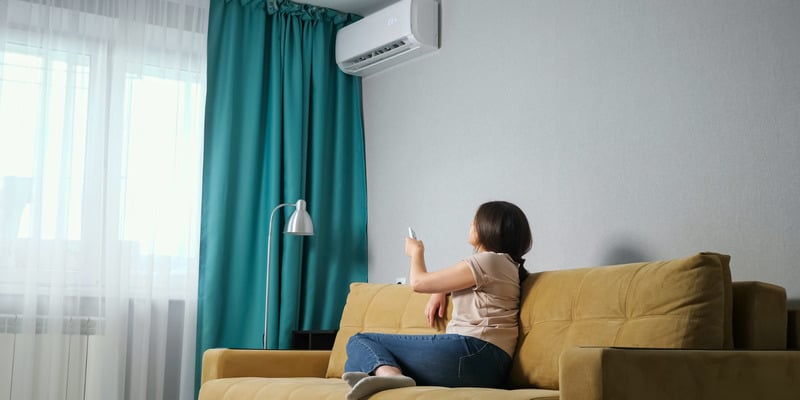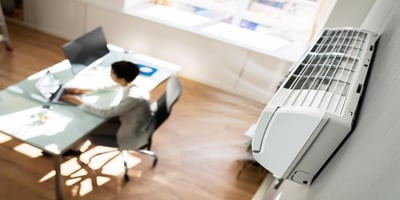Why Water Dripping From AC Indoor Unit: Top Common Problems
Let’s start with a situation. You're watching Netflix when you hear drip, drip, drip coming from your living room. You follow the sound and find a growing puddle beneath your indoor AC. Your relaxing evening just became a homeowner's emergency. Water dripping from a split AC indoor unit like this happens to thousands of people every summer, usually at the worst possible times.
Air conditioners aren't supposed to leak water inside your home. When they do, something has gone seriously wrong with a process that normally works invisibly behind the scenes. The problem? Most AC unit issues develop slowly over weeks or months before you see that first drip. By then, a simple maintenance task has often become an expensive repair job.
Your air conditioner pulls gallons of water from your home's air every day - sometimes 20+ gallons during humid summer weather. This moisture doesn't vanish magically. The evaporator coil acts like a giant cold surface, condensing water vapor just like droplets forming on an iced drink. Normally, this water follows a planned route: drain pan → condensate line → outside your home. But when any part of this system fails, you get leaking water from an air conditioner.
Blocked Condensate Drains: The Silent Saboteur
Your condensate drain line might be only three-quarters of an inch wide, but it carries enormous responsibility during cooling season. These hidden pipes live inside walls, crawl spaces, or utility areas where homeowners never see them. That invisibility becomes a major problem.
What builds up inside drain lines:
- Algae thriving in dark, wet conditions
- Dust particles sticking to moist surfaces
- Tiny insects and their debris
- Mineral deposits from hard water
- Soap residue from nearby laundry areas
The sneaky part? Blockages develop gradually. Water backs up slowly, first filling the primary drain pan, then overflowing into secondary areas, and finally appearing where you'll actually notice it. Many homeowners discover water leaking from the AC indoor unit weeks after the initial blockage formed.
Professional technicians get creative with stubborn clogs. Some use wet vacuums to suck debris through the line. Others blast compressed air to dislodge obstructions. The worst blockages need chemical treatments or complete line replacement.
Red flags that your drain line needs attention:
- Musty smells near the indoor AC
- Water stains on walls or ceilings
- Reduced cooling performance
- Higher humidity levels indoors
- Visible mold growth around the unit
Air Filter Chaos Creates Perfect Storms
Leaking water from the new AC often surprises homeowners because they assume new equipment won't have problems. But dirty air filters can wreck even brand-new systems within months of installation.
Clogged filters create a domino effect. Restricted airflow makes the evaporator coil too cold. Instead of maintaining proper condensation temperatures, the coil freezes water as it collects. Ice blocks airflow further, making the problem worse. When ice finally melts, it produces far more water than your drainage system can handle.
Timing matters here. Filter problems typically surface during heat waves when people run their systems continuously for days. The accumulated stress finally reaches a breaking point, and suddenly you're dealing with AC that is leaking water inside your home.
Filter replacement schedules that actually work:
- Basic fiberglass filters: monthly during peak season
- Pleated filters: every 3 months (2 months in dusty areas)
- High-efficiency filters: every 6 months (check monthly)
- Homes with pets: reduce all timeframes by 25-50%
- Post-storm inspection: always check after major dust events
Smart homeowners check filters after unusual weather, during pollen season, and anytime cooling performance drops. This proactive approach prevents most filter-related water problems.
 Drain Pan Failures Hit Without Warning
Drain Pan Failures Hit Without Warning
The drain pan sits beneath your evaporator coil, catching condensation year-round. Most people forget this component exists until it fails spectacularly.
Common drain pan problems:
- Cracking - Temperature changes cause expansion/contraction
- Corrosion - Metal pans rust from constant moisture exposure
- Warping - Creates low spots where water pools instead of draining
- Misalignment - Vibration or settling shifts pan position
- Overflow - Excessive condensation exceeds pan capacity
Secondary drain pans often provide false security. These backup systems can have their own installation problems, inadequate sizing, or poor positioning that allows water to bypass them completely. Some lack proper drain connections, becoming nothing more than temporary water collectors.
Installation quality determines long-term drain pan performance. Units must be perfectly level or slightly tilted toward drains. Even quarter-inch deviations can cause water to pool in corners or overflow unexpectedly.
The Ice Age Phenomenon
Frozen evaporator coils create the most dramatic leaking water from an air conditioner scenarios. Unlike slow drips from minor issues, ice problems can flood areas when accumulated ice melts rapidly.
What causes coil freezing:
- Dirty air filters (most common)
- Low refrigerant levels from leaks
- Blocked return air vents
- Malfunctioning thermostats
- Extremely dirty evaporator coils
- Oversized AC unit for the space
Refrigerant leaks develop slowly over the years. Connections loosen from vibration and temperature cycling. Copper lines develop pinhole leaks from corrosion. Even tiny leaks eventually reduce refrigerant enough to cause freezing.
The melting process creates urgent situations. Large ice accumulations can melt quickly when temperatures rise or when homeowners try speeding up the process. Sudden water volume overwhelms drainage systems designed for steady flow, not rapid melting.
Emergency steps for frozen coils:
- Turn off the AC unit immediately
- Switch fan to "on" to help melting
- Remove any visible ice carefully
- Place towels around the unit
- Call professional service
- Don't restart until professionally cleared
Installation Disasters Lurking in Your Walls
Poor installation creates potential water leaking problems in your AC that might not appear for months or years. These hidden mistakes often surface during peak usage periods when systems face maximum stress.
Critical installation factors:
- Proper unit positioning and leveling
- Correct condensate line routing and slopes
- Adequate secondary protection systems
- Proper electrical connections and controls
- Appropriate refrigerant line installation
Some installers prioritize aesthetics or convenience over proper drainage slopes. The result? Water pools instead of flowing toward drains. Sharp bends in drain lines, improper fittings, or inadequate support create restriction points that eventually cause backups.
Building codes require overflow protection in many areas - secondary drain pans, backup drain lines, or water sensors that shut down systems before major leaks occur. Corner-cutting installations eliminate these safeguards.
Modern HVAC systems need installers who know mechanical, electrical, and plumbing principles. Inexperienced technicians might connect everything correctly but miss subtle details affecting long-term reliability.
 Refrigerant Problems: The Invisible Enemy
Refrigerant Problems: The Invisible Enemy
Low refrigerant creates cascading problems that often end with leaking water from the AC indoor unit. Unlike other issues homeowners can tackle, refrigerant problems need professional attention due to environmental regulations and safety concerns.
Signs of refrigerant leaks:
- Ice forming on indoor coils
- Reduced cooling capacity
- Longer run times to reach set temperatures
- Higher energy bills
- Hissing sounds from refrigerant lines
- Oil stains near connection points
Refrigerant leaks rarely announce themselves dramatically. They cause gradual performance changes many people blame on aging equipment or hot weather. The evaporator coil starts operating at lower temperatures, ice formation becomes likely, and freeze-thaw cycles create excessive water production.
Detection requires specialized equipment. Electronic sensors identify refrigerant in the air. Ultraviolet dyes make tiny leaks visible under special lights. Even obvious leaks need proper repair, system evacuation, and precise recharging.
Environmental regulations make refrigerant work both expensive and urgent. Older refrigerants face phase-outs, replacement costs keep rising, and disposal requirements become stricter yearly.
Prevention Strategies That Beat the Odds
Smart monitoring approacheds:
- Install water sensors near indoor AC units
- Use smart thermostats tracking performance patterns
- Monitor energy bills for unusual increases
- Check drain line outlets monthly during cooling season
- Schedule professional maintenance before problems develop
Technology offers new prevention tools. Smart thermostats track run times, energy use, and temperature patterns indicating developing issues. Water sensors provide early leak warnings before major damage occurs. Some systems integrate with home automation to shut down equipment automatically when problems arise.
Environmental factors affect system longevity significantly. High humidity, excessive dust, or poor air circulation accelerate component wear. Address these conditions through improved ventilation, enhanced filtration, or dedicated humidity control.
Seasonal Preparation Checklist
Spring startup:
- Inspect and clean drain pans
- Check condensate line flow
- Replace air filters
- Clear vegetation from outdoor units
- Test system operation before hot weather
Fall shutdown:
- Clean or replace filters
- Inspect drain lines for blockages
- Check for any summer damage
- Schedule professional maintenance
- Prepare for heating season transition
The Real Cost of Ignoring Water Problems
Damage caused by leaking water from an air conditioner extends far beyond obvious puddles. Water affects flooring, drywall, electrical systems, and personal belongings. Mold growth can begin within 24-48 hours of water exposure, creating health risks and remediation costs.
Insurance coverage for air conditioning leaks varies dramatically. Many policies exclude damage from maintenance-related failures or gradual leaks. Prevention remains the most reliable protection strategy.
Professional maintenance relationships provide ongoing support beyond emergency repairs. Experienced technicians become familiar with specific systems, track performance trends over time, and often spot potential problems during routine visits.
The financial math favors prevention overwhelmingly. Annual maintenance costs typically range from $150-300, while major water damage repairs can exceed $5,000-15,000 depending on affected areas and duration of exposure.
Taking Action Before Disaster Strikes
Water dripping from a split AC indoor unit catches most homeowners unprepared, but recognizing warning signs allows proactive responses. System interconnections mean minor issues cascade into major problems quickly, making early intervention crucial for reliable operation.
Property protection requires multiple strategies working together. Regular maintenance, environmental monitoring, professional relationships, and emergency preparedness combine to create comprehensive protection against water damage.
Your AC unit represents a significant investment requiring ongoing attention for peak performance. Recognize developing problems, implement thorough maintenance practices, and work with qualified professionals when needed. These steps protect both comfort and property value while avoiding the stress and expense of emergency repairs.







































